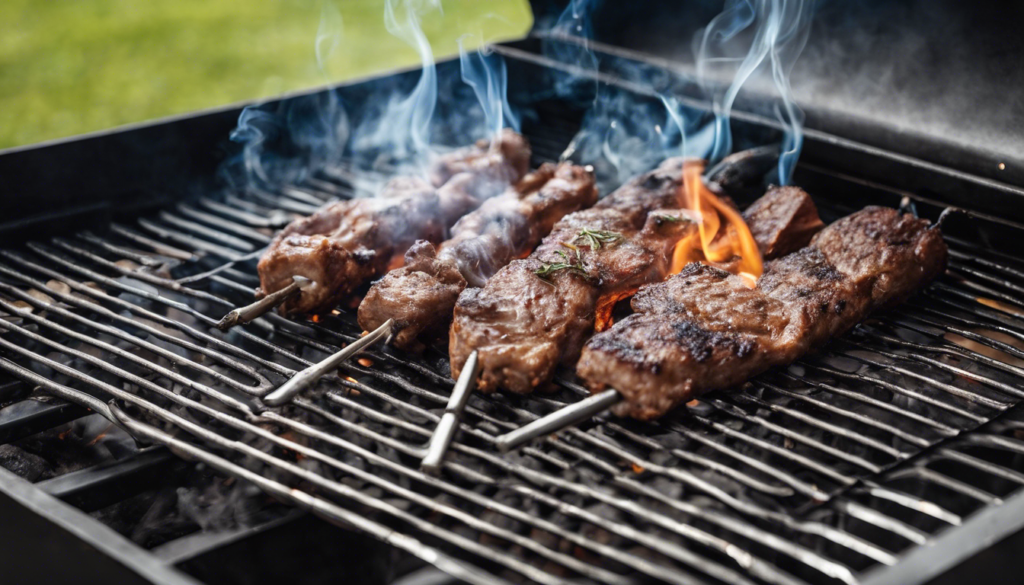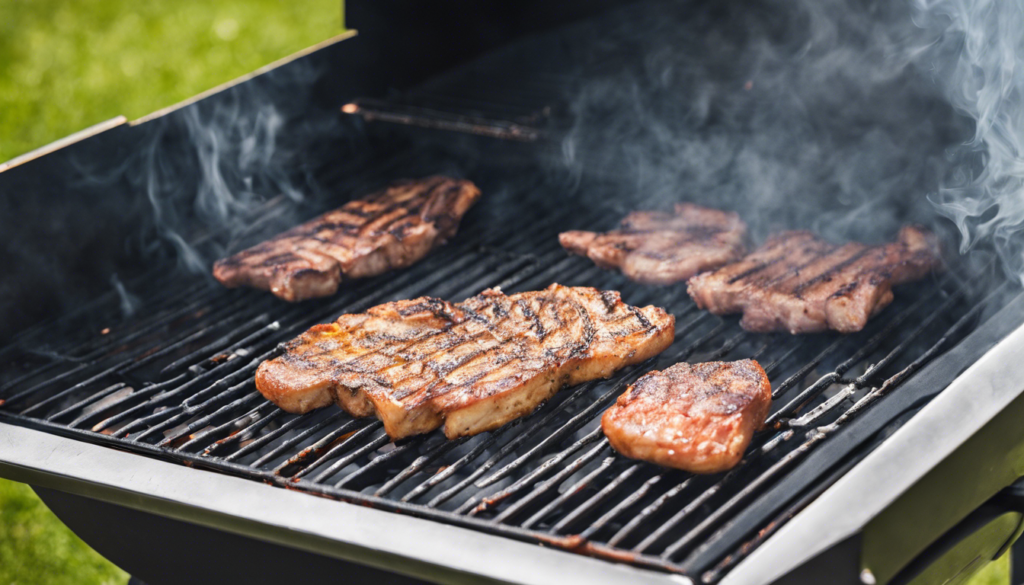Mastering the Art of Gas Grill Smoking
From the sweet aroma of hickory to the alluring scent of applewood, gas grill smoking offers a unique culinary adventure that is both exciting and rewarding. This article is your comprehensive guide to mastering the art of gas grill smoking. By the end, you’ll know the ins and outs of selecting the right grill, choosing the best meat, and controlling the temperature for perfect results every time. So, why should you master gas grill smoking? Because it’s not just about cooking; it’s about crafting a gastronomic masterpiece that will leave your guests in awe.
Understanding the Basics of Gas Grill Smoking
Gas grill smoking is a cooking technique that uses a gas grill and wood chips to infuse food, particularly meat, with a smoky flavor. The smoke from the wood chips permeates the meat, giving it a distinct taste and aroma that is hard to achieve with other cooking methods.
Unlike charcoal grilling, where the meat is cooked directly over the coals, gas grill smoking involves indirect heat. The meat is placed away from the flame, and the grill is closed to create a smoky environment. This slow and low method of cooking results in tender, juicy, and flavorful meat.
But how does it compare to other smoking methods? Let’s look at the table below:
| Smoking Method | Flavor | Ease of Use |
|---|---|---|
| Gas Grill Smoking | Mild, customizable | Easy |
| Charcoal Smoking | Strong, distinct | Moderate |
| Electric Smoking | Mild, consistent | Very easy |
The Art of Choosing the Right Gas Grill for Smoking
Choosing the right gas grill is the first step towards mastering the art of gas grill smoking. There are several factors to consider, including the size of the grill, the number of burners, the material of the grill grates, and the presence of a smoker box or an option to add one.
The size of the grill should match your cooking needs. If you often cook for large gatherings, go for a larger grill. The number of burners is also important. More burners give you more control over the heat distribution. As for the grill grates, cast iron grates are preferred for their heat retention and durability. Lastly, a smoker box is a handy feature for gas grill smoking. It’s where you put the wood chips for smoking.
Considering these factors, here are our top recommended gas grills for smoking:
- Weber Genesis II E-335
- Napoleon Prestige 500
- Broil King Regal S590 Pro
Essential Tools for Gas Grill Smoking
Aside from the grill itself, there are other tools you need for gas grill smoking. These include wood chips, a smoker box (if your grill doesn’t have one), a meat thermometer, tongs, a basting brush, and a grill brush for cleaning.
Each tool plays a crucial role in the smoking process. Wood chips provide the smoke for flavoring the meat. The smoker box holds the wood chips. The meat thermometer ensures your meat is cooked to the right temperature. Tongs are used for handling the meat, while the basting brush is for applying sauces or marinades. Finally, the grill brush is for cleaning the grill grates after smoking.
Here’s a table summarizing the tools and their importance:
| Tool | Importance |
|---|---|
| Wood Chips | Provide smoke for flavoring the meat |
| Smoker Box | Holds the wood chips |
| Meat Thermometer | Ensures meat is cooked to the right temperature |
| Tongs | For handling the meat |
| Basting Brush | For applying sauces or marinades |
| Grill Brush | For cleaning the grill grates |
Selecting the Best Meat for Gas Grill Smoking
When it comes to gas grill smoking, not all meats are created equal. Some cuts and types of meat take well to the slow and low cooking method of smoking, while others do not. The best meats for gas grill smoking are those with a good amount of fat and connective tissue, such as pork shoulder, beef brisket, and chicken thighs. These cuts become incredibly tender and flavorful when smoked.
Choosing high-quality meat is also crucial. Look for meat with a good marbling of fat, as this will melt during smoking, keeping the meat moist and adding flavor. Avoid cuts that are too lean, as they can become dry when smoked.
Here are some tips for choosing high-quality meat:
- Choose fresh over frozen whenever possible.
- Look for even marbling.
- Avoid meat with a lot of connective tissue.
Importance of Wood Chips in Gas Grill Smoking
Wood chips are the heart and soul of gas grill smoking. They are responsible for the smoke that gives the meat its unique flavor. Different types of wood chips impart different flavors, so you can experiment to find your favorite.
For example, hickory and mesquite wood chips give a strong and robust flavor, perfect for red meats. Apple and cherry wood chips provide a sweet and fruity smoke, great for poultry and pork. And for a mild, versatile flavor, you can’t go wrong with oak wood chips.
Remember, the type of wood chips you use can make or break your smoking experience, so choose wisely. Here’s a table to guide you:
| Type of Wood Chips | Flavor | Best For |
|---|---|---|
| Hickory | Strong, robust | Red meats |
| Mesquite | Strong, earthy | Red meats |
| Apple | Sweet, fruity | Poultry, pork |
| Cherry | Sweet, mild | Poultry, pork |
| Oak | Mild, versatile | All types of meat |
Preparing Your Meat for Gas Grill Smoking
Preparing your meat for smoking involves more than just taking it out of the fridge. There are several steps you need to follow to ensure your meat is ready for the grill.
First, trim any excess fat from the meat. While some fat is good for smoking, too much can cause flare-ups. Next, apply a dry rub or marinade to the meat. This will not only add flavor but also help form the delicious crust, or “bark,” on the outside of the meat. After applying the rub or marinade, let the meat sit in the fridge for at least a few hours, or even overnight. This allows the flavors to penetrate the meat.
Marinating and seasoning are crucial to the flavor of your smoked meat. They add depth and complexity, turning a simple piece of meat into a mouthwatering meal. Here’s a simple recipe for a basic BBQ dry rub:
- 1/2 cup brown sugar
- 1/2 cup paprika
- 1 tablespoon black pepper
- 1 tablespoon salt
- 1 tablespoon chili powder
- 1 tablespoon garlic powder
- 1 tablespoon onion powder
- 1 teaspoon cayenne pepper
Setting Up Your Gas Grill for Smoking
Setting up your gas grill for smoking involves several steps. First, preheat your grill to the desired temperature. For most meats, this is around 225°F (107°C). Next, add your wood chips to the smoker box. If your grill doesn’t have a smoker box, you can make one out of aluminum foil. Place the smoker box on the grill grates, over one of the burners. Turn on the burner under the smoker box, and leave the other burners off. This creates a hot zone (for the wood chips to smolder and produce smoke) and a cool zone (where the meat will cook).
Place your meat on the grill grates, in the cool zone. Close the lid of the grill, and let the magic happen. The smoke from the wood chips will circulate inside the grill, infusing the meat with a delicious smoky flavor.
Remember, safety is paramount when using a gas grill. Always keep a fire extinguisher nearby, and never leave the grill unattended. Also, make sure the grill is on a flat, stable surface, away from flammable materials.
Mastering the Temperature for Gas Grill Smoking
Temperature control is crucial in gas grill smoking. Too hot, and the meat will dry out. Too cold, and the meat won’t cook properly. The ideal temperature for smoking most meats is around 225°F (107°C). To maintain this temperature, adjust the burners as needed. If the temperature is too high, turn down the burners. If it’s too low, turn them up.
It’s also important to maintain a consistent temperature. Fluctuations in temperature can lead to uneven cooking. To help maintain a consistent temperature, avoid opening the grill lid unless necessary. Every time you open the lid, heat escapes, causing the temperature to drop.
Here are some tips for maintaining the right temperature:
- Use a grill thermometer to monitor the temperature.
- Adjust the burners as needed to increase or decrease the temperature.
- Avoid opening the grill lid unless necessary.
- If using a gas grill with multiple burners, use the 2-zone cooking method. This involves turning on one burner (the hot zone) and leaving the other burner(s) off (the cool zone). The meat is placed in the cool zone, away from direct heat.
The Smoking Process: Step-by-Step Guide
Now that you’ve prepared your meat and set up your grill, it’s time for the main event: the smoking process. Here’s a step-by-step guide:
- Preheat your grill to the desired temperature (usually around 225°F).
- Add your wood chips to the smoker box, and place it on the grill grates, over one of the burners.
- Turn on the burner under the smoker box, and leave the other burners off.
- Place your meat on the grill grates, in the cool zone.
- Close the lid of the grill, and let the meat smoke. The smoking time will depend on the type and size of the meat. As a general rule, smoking takes about 1 to 1.5 hours per pound of meat.
- Check the temperature of the meat with a meat thermometer to ensure it’s cooked to the right temperature. For example, pork should be cooked to an internal temperature of 145°F, while poultry should be cooked to 165°F.
- Once the meat is done, remove it from the grill, and let it rest for at least 15 minutes before slicing and serving.
While smoking is a relatively straightforward process, there are some common mistakes to avoid. These include using too much wood chips (which can lead to overly smoky flavor), not controlling the temperature properly, and not letting the meat rest after smoking.
Checking the Doneness of Your Smoked Meat
How do you know when your smoked meat is done? The best way is to use a meat thermometer. Insert the thermometer into the thickest part of the meat, without touching the bone. The meat is done when it reaches the recommended internal temperature. For example, pork should be cooked to an internal temperature of 145°F, while poultry should be cooked to 165°F.
Don’t rely on the color of the meat to determine doneness. Smoked meat often has a pinkish hue, even when fully cooked. This is known as a “smoke ring,” and it’s a sign of a well-smoked meat.
Here’s a table with the recommended internal temperatures for different types of meat:
| Type of Meat | Recommended Internal Temperature |
|---|---|
| Pork | 145°F |
| Poultry | 165°F |
| Beef (medium rare) | 130°F to 135°F |
| Beef (medium) | 140°F to 145°F |
| Beef (well done) | 160°F and above |
Resting and Serving Your Smoked Meat
After hours of smoking, it’s tempting to dig into your meat right away. But resist the temptation, and let your meat rest for at least 15 minutes before slicing and serving. Resting allows the juices to redistribute throughout the meat, resulting in a moist and flavorful meal.
When it’s time to serve, slice the meat against the grain for maximum tenderness. And don’t forget the side dishes! Smoked meat pairs well


